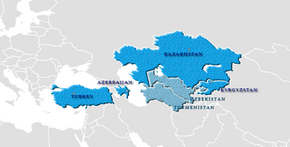Organization:International Turkic Academy
This article has multiple issues. Please help improve it or discuss these issues on the talk page. (Learn how and when to remove these template messages)
(Learn how and when to remove this template message)
|
International Turkic Academy | |
|---|---|
 Members | |
| Headquarters | Nur-Sultan, Kazakhstan |
| Membership | Member states Azerbaijan, Kazakhstan, Kyrgyzstan, Turkey |
| Establishment | |
• IX summit of the Heads of Turkic-speaking states | 3 October 2009, |
Website twesco.org | |
The International Turkic Academy is an academic center coordinating scientific researches on the language, literature, culture, history of Turkic people from ancient times to the present-day and evaluating the contribution of the Turkic civilization to the human civilization on the basis of indigenous sources. The academy aims to boost the scientific cooperation across the Turkic world, help the initiatives of scholars from Turkic-speaking states and organize academic meetings on a regular basis.
History
At the IX summit of the Heads of the Turkic Speaking States held in Nahchivan, Azerbaijan, on 3 October 2009, the President of the Republic of Kazakhstan Nursultan Nazarbayev proposed to set up an international research center tasked with conducting researches on the Turkic world.
On 28 May 2010, the Turkic Academy was founded at the Palace of Peace and Reconciliation in the capital of the Republic of Kazakhstan. Presidents of Kazakhstan, Nursultan Nazarbayev, and Turkey, Abdullah Gul, and well-established turkologist-scholars from the US, Russia (Tatarstan, Bashkortostan, Chuvashia, Yakuti), Uzbekistan, Kyrgyzstan, Ukraine attended the opening ceremony of the unique research center.
At the II summit of the Turkic Council held on 22–23 August 2012 in the capital of the Kyrgyz Republic, the President of the Republic of Kazakhstan Nursultan Nazarbayev, the President of the Republic of Turkey Abdullah Gul, the President of the Kyrgyz Republic Almazbek Atambayev and the Prime-Minister of the Republic of Azerbaijan Artur Rasizade signed an agreement on giving an international status to the Turkic Academy. Following completion of ratification procedures, the Turkic Academy, which was functioning in Kazakhstan from 2010, attained an international status on 28 August 2014.
Founder States
- Republic of Azerbaijan
- Republic of Kazakhstan
- Republic of Kyrgyzstan
- Republic of Turkey
International partnership
The International Turkic Academy has signed around 40 memorandums with research institutions and turkological centers. The list includes the Hungarian National Academy of Sciences and its research centers, National Academy of Sciences of the Kyrgyz Republic, Azerbaijan National Academy of Sciences, Mongolian Academy of Sciences and its research institutions, and research centers of the Russian Academy of Sciences. In addition, the Academy has strong relationships with top universities of South Korea, USA and Turkey, as a result, a number of outstanding projects are being carried out in collaboration with almost 100 foreign turkologist-scholars. International Turkic Academy has established partnerships with Turkic Council, TurkPA, Turksoy, and with Research Center for Islamic History, Art and Culture (IRCICA) as well.
Structure
Academic Council
Academic Council is the highest body of the International Turkic Academy. The organization is administered by the Academic Council composed of one representative from each Member State, the President of the Turkic Academy and Vice-Presidents.
President
President is nominated from among the citizens of Member States for a term of four years with the possibility of re-election. The first President of the International Turkic Academy is a Doctor of Historical sciences-Darkhan Kydyrali. He was nominated for this post by the Heads of Member States at the IV summit of Turkic Council held on 4–5 June 2014 in Bodrum, Turkey. Since International Turkic Academy is based in Kazakhstan, the first President was appointed from Kazakhstan. The position of the President will pass to other member countries on a four-year rotation basis in alphabetical order according to their names in English: Azerbaijan, Kyrgyzstan and Turkey.
Vice-Presidents
Since the President of the International Turkic Academy is a citizen of Kazakhstan, for the positions of Vice-Presidents three Vice-Presidents will be nominated from other Member States (Azerbaijan, Kyrgyzstan and Turkey).
Research centers
Five research centers were formed within the International Turkic Academy. They are: Center for History and Ethnology, Center for Language, Literature and Terminology, Center for Arts and Culture, Center for Socio-Economic Researches, and Center for International Researches. These centers are committed to the study of key social, cultural, historical, economic issues pertaining to the Turkic world.
Publications
Scholars working in the International Academy are from the founder countries and the Turkic world as a whole. The academy completed a number of unique international projects. Over the last four years around 50 books have been published. They cover a wide range of issues including the Turkic history, culture, art, and the future of Turkic people. The academy also publishes scientific and analyticial journals with articles in four languages (Kazakh, Russian, English, Turkish), such as-“Altaistics and Turkology”, which provides scientific analyses of issues in turkology and altaistics, and “Global Turk”. In addition, the Academy produced dictionaries of Turkic languages. The academy organized several international conferences, forums, meetings and seminars dedicated to the Turkic history, culture and to the distinguished figures of the Turkic world.
Turkic library
Within the International Turkic Academy functions a Turkic Library. The library formed out of the personal libraries of renowned turkologists consists of more than 30 thousand books. The personal libraries of widely known turkologists such as Abduali Kaidar, Abjan Kuryshjanuly and Mandoky Kungur Ishtvan were also bestowed to this library. The library has exceptional books and manuscripts as well. There are separate book shelves for every Turkic nation. To be precise, it is possible to find books on Kazakhs, Turks, Azerbaijans, Uzbeks, Turkmens, Bashkirs, Tatars, Karachais, Chuvashs, Karakalpaks, Nogais, etc. The electronic data base of the Turkic Library is in the process of creation.
Museum
It is possible to see valuable artefacts created by Turkic people in different developmental periods in the museum of the International Turkic Academy. Works regarding the collection and systematization of material and spiritual legacies of Turkic people are in progress.
External links

